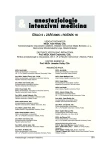Some prognostic indicators in elderly patients in intensive care
Authors:
J. Špunda 1; J. Lejsek 1; P. Cvrčková 1; M. Hladíková 2
Authors‘ workplace:
Klinika anesteziologie a resuscitace 2. LF UK a IPVZ ve FN v Motole, Praha
1; Ústav lékařské informatiky 2. LF UK, Praha
2
Published in:
Anest. intenziv. Med., 16, 2005, č. 5, s. 235-241
Category:
Anaesthesiology - Original Paper
Overview
Objective:
The study was focused on the challenges in geriatric critical care and establishing the criteria for morbidity and mortality reduction.
Design:
Retrospective patient’s data study.
Setting:
Department of Anaesthesiology and Intensive Care of the University Hospital.
Materials and Methods:
Our study included 124 patients of over 70 years of age admitted to critical care. The analyzed set consisted of 78 surgical and 46 medical patients (internal diseases, admission after CPR). We analysed the admission and in-hospital data with the objective to identify mortality co-factors and statistically significant premorbid factors.
Results:
Most patients in the set were over 75 (56.4 %). Their mortality was significantly higher than the mean mortality (50.0 % vs. 36.3 %, P = 0.047). Pre-admission cardiovascular (P = 0.048) and respiratory (P = 0.03) diseases were very frequent in the past medical history. Fortynine patients were admitted in pre-shock condition (5 died), the other 75 had fully developed shock (40 died). Total mortality in the set was 36.3 % (25.6 % in surgical patients, 54.3 % in medical patients). Mortality was higher – 33.3 % (P <0.05) – in patients after urgent surgery, in patients with developed shock (P < 0.0005) and those with delayed admission to critical care (P = 0.005). Significant for higher mortality was the necessity for pharmacological haemodynamic support (P = 0.001), mechanical ventilation longer than 6 days (P < 0.0005) and renal replacement therapy (P = 0.027).
Conclusion:
Critical care is a demanding integral part of geriatric medicine. Better results can be achieved if differentiated care system is consistently applied. Relevant and optimally timed care according to the existing risks can both manage the acute state of the illness and offer a satisfactory quality of further life.
Key words:
geriatrics – data collection – comorbidity – life support care – mortality
Labels
Anaesthesiology, Resuscitation and Inten Intensive Care MedicineArticle was published in
Anaesthesiology and Intensive Care Medicine

2005 Issue 5
Most read in this issue
- Curare: Alternative methods of administration
- Curare: Some historical facts
- Development in anaesthetic technique in the extremely low weight infant, 1998–2003
- The Czech contribution to the advance in the interpretation of acid-base disturbances
